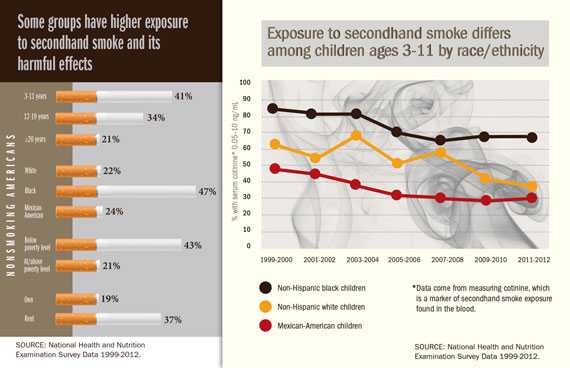Secondhand Smoke
An Unequal Danger
February 2015


 58 million
58 million
1 in 4 nonsmokers (58 million people) in the US are still exposed to secondhand smoke (SHS).
 2 in 5
2 in 5
About 2 in every 5 children (including 7 in 10 black children) are exposed to SHS.
 1 in 3
1 in 3
More than 1 in 3 nonsmokers who live in rental housing are exposed to SHS.
No level of secondhand smoke (SHS) exposure is safe. SHS exposure occurs when nonsmokers breathe in smoke exhaled by smokers or from burning tobacco products. It kills more than 400 infants and 41,000 adult nonsmokers* every year. Exposure to SHS among US nonsmokers has declined, but progress has not been the same for everyone. SHS exposure is more common among children ages 3 to 11 years, blacks, people living below the poverty level, and those who rent housing.
State and city officials can help protect children and adult nonsmokers from SHS in the places they live, visit, and work by using proven methods to eliminate smoking in:
- Indoor areas of all public places such as restaurants, bars, casinos, and other private worksites.
- Multiunit housing such as apartments, condominiums, and government funded housing.
*Infant deaths due to secondhand smoke-related Sudden Infant Death Syndrome. Deaths among nonsmoking adults due to secondhand smoke-related lung cancer and heart disease.
Problem
58 million nonsmokers in the US are still exposed to secondhand smoke.
Who is most at risk?
SHS exposure dropped by half from 1 in 2 nonsmokers in 1999-2000 to 1 in 4 nonsmokers in 2011-2012, but exposure remains especially high for certain groups.
- 2 in 5 children (about 15 million) ages 3 to 11 are exposed to SHS.
- Nearly half of black nonsmokers are exposed to SHS, including 7 in 10 black children.
- More than 2 in 5 nonsmokers who live below the poverty level are exposed to SHS.
- More than 1 in 3 nonsmokers who live in rental housing are exposed to SHS.
Homes are a major source of exposure.
Eliminating smoking in indoor spaces fully protects nonsmokers from exposure to SHS. Half of the US population is covered by state or local smokefree laws that do not allow indoor smoking in worksites and public places, including restaurants and bars. Most people have adopted smokefree rules in their home. Still, exposure in the home remains a significant problem.
- The home is the primary source of SHS exposure for children.
- About 80 million (1 in 4) Americans live in multiunit housing and can be exposed to unwanted SHS in their homes. SHS from units or common areas where smoking occurs can seep into smokefree units.
- Many who live in public housing are especially affected by SHS, including children, the elderly, and people with disabilities.
View larger image and read text description.
Top of PageWhat Can Be Done
Federal government is
- Monitoring SHS exposure, educating the public about the dangers of SHS, conducting research, funding programs that work to reduce tobacco use and exposure to SHS in public places, and regulating tobacco products.
- Funding and promoting tobacco education campaigns, such as CDC's Tips From Former Smokers, that teach people how smoking and SHS exposure can harm them.
- Encouraging smokefree policies in subsidized and public housing.
- Creating tobacco- and smoke-free environments for employees, customers, and partners.
States and communities can
- Work to prohibit smoking in all indoor public places and worksites, including restaurants, bars, and casinos.
- Support efforts to prohibit smoking in multiunit housing.
- Fund comprehensive tobacco prevention and control programs at CDC-recommended levels to reach underserved populations, including those with the greatest burden of SHS exposure.
Doctors, nurses, and other health care providers can
- Ask their patients whether they use tobacco products, encourage those who do to quit, and provide help with quitting.
- Encourage their nonsmoking patients to avoid exposure to SHS where they work, live, and gather.
- Talk with their patients about the dangers of SHS.
Everyone can
- Call 1-800-QUIT-NOW or go to www.smokefree.gov for free help, if they or someone they know smokes and wants to quit.
- Make their homes and vehicles 100% smokefree. Opening a window or using fans or air fresheners does not protect nonsmokers from the dangers of SHS.
- Not allow anyone to smoke around children and avoid all public places where smoking is allowed.
- Talk to children about why they shouldn't smoke or be around SHS.
(Visit www.cdc.gov/tobacco/data_statistics/sgr/2012/)
Science Behind the Issue
Related Pages
- Vital Signs Issue details: Disparities in Nonsmokers' Exposure to Secondhand Smoke — United States, 1999–2012, Morbidity and Mortality Weekly Report (MMWR)
- Prevalence of Smokefree Home Rules — United States, 1992–1993 and 2010–2011, Morbidity and Mortality Weekly Report (MMWR)
- How to Quit Resources
- Secondhand Smoke
- Health Effects of Secondhand Smoke
- 2014 Surgeon General's Report: The Health Consequences of Smoking—50 Years of Progress
- CDC's Best Practices for Comprehensive Tobacco Control Programs—2014
- CDC's Tobacco-Free Campus Policy
- Vital Signs – SecondhandSmoke [PODCAST - 1:15 minutes]
- Vital Signs – SecondhandSmoke [PSA - 0:60 seconds]
On Other Web Sites
- MedlinePlus - Secondhand Smoke
- The Community Guide: Reducing Tobacco Use and Secondhand Smoke Exposure
- Smoke-Free Homes Program (Environmental Protection Agency)
- Page last reviewed: February 3, 2015
- Page last updated: February 3, 2015
- Content source:
Error processing SSI file


 ShareCompartir
ShareCompartir

